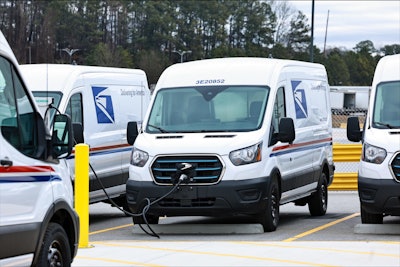
United States Postal Service (USPS) on Monday unveiled its first set of electric vehicle (EV) charging stations at its South Atlanta Sorting and Delivery Center (S&DC). These charging stations that will serve as a model for hundreds of new S&DCs across the country throughout the year and will be equipped with infrastructure to power more than 66,000 USPS electric delivery vehicles.
The Postal Service expects to convert approximately 400 selected sites into S&DCs nationwide. These centers — which provide faster and more reliable mail and package delivery over a greater geographic area — will serve as the local hubs to deploy EVs along local carrier routes. The Postal Service has opened 29 S&DCs nationwide as of January 2024.
 This week USPS agreed to purchase six battery-electric Canoo vehicles and will take delivery of these six right-hand drive versions of Canoo's LDV 190 in the coming months. Canoo's vehicles feature a modular electric platform.
This week USPS agreed to purchase six battery-electric Canoo vehicles and will take delivery of these six right-hand drive versions of Canoo's LDV 190 in the coming months. Canoo's vehicles feature a modular electric platform.
Postmaster General Louis DeJoy said the transformation of USPS operating processes and the investment in new automation, new technologies, and upgraded facilities and vehicles, "will generate significant efficiencies that reduce our costs, slash our carbon footprint and minimize waste."
The charging stations displayed at the Atlanta S&DC were manufactured by Siemens. These stations will be able to efficiently charge Postal Service EVs overnight prior to the next day’s deliveries. The Postal Service’s first 14,000 EV chargers will be manufactured by three suppliers: Siemens, Rexel/ChargePoint and Blink.
Deployment of electric delivery trucks will start in Georgia before expanding to other locations across the country throughout the year. The vehicles feature air conditioning and advanced safety technology and are designed to meet modern operational requirements.
Updating and modernizing the Postal Service’s fleet will allow delivery vehicles to haul larger volumes of mail and packages. For example, the Ford E-Transits displayed at Monday's unveiling have nearly three times the cargo capacity of the Grumman LLV delivery vehicles that the Postal Service currently uses. Increased cargo capacity will reduce inefficient transportation, improve delivery operations and eliminate the need for many second trips carriers take to deliver high volumes of packages.
USPS plans on procuring a total of 21,000 EVs — including 9,250 from Ford — depending on market availability and operational feasibility, and anticipates adding at least 45,000 battery-electric Next Generation Delivery Vehicles (NGDVs) by 2028, bringing the total number of EVs in the delivery fleet to more than 66,000.
 Aerial image of the South Atlanta Sorting and Delivery Center electric vehicle (EV) charging stations.
Aerial image of the South Atlanta Sorting and Delivery Center electric vehicle (EV) charging stations.









